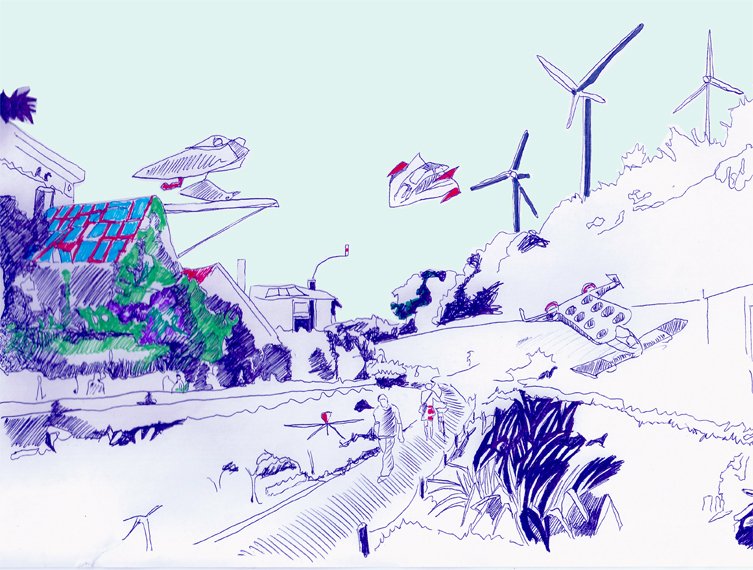One of the major narratives that has guided our economic lives until now was the one of “growth”. One could call it “growth paradigm”. The growth story used to tell us ( and to many, it still does) that overall, growth was/is a good thing, and that this is the way the story shall be written, now and into the future.
Undeniably, growth brought some of us real benefits such as increased access to education, well-being and improved living standards. The other side of the coin though, is known to all: inequality, global warming, loss of community, and the destruction of nature. This has led many to challenge the traditional metrics of economic growth.
On an ironic twist, even though the mainstream economic system propelling our economy is still based on concepts of growth (and its metrics), it is becoming quite clear, according to the same metrics (!) the global economic growth is actually slowing down. Forecasts of low growth, negative interest rates and stagnant and/or declining wages in the western world, invade the news every day.
Sooner or later we will have to face a new unavoidable reality and ask questions such as:
‘what are we capable of without economic growth?’
How would the world function in a post growth scenario?
There is a set of crucial questions that until recently, only the fringes of society used to ponder upon. Those questions, are now, slowly but steadily, moving into mainstream debate. These are:
“Is there a limit to growth ? How much is enough? What is the threshold beyond which growth brings deleterious results ? How will the world function if growth really slows down? What solutions can we find to such a scenario?”
A quite original movement that has tried to provide some answers to these questions for quite a while, is the “Post growth” movement. Post growth ideas are nothing new. Previous thinkers have addressed them, such as renowned economic theorist E.F. Schumacher, the author of the book “Small is Beautiful”.
Post growth movement assembles diverse organizations that look at possible solutions to proactively respond to the limits-to-growth dilemma, which is seen as a positive thing.
The term “post-growth” is different from the “de-growth” approach, as it acknowledges that sustainable economic growth can generate beneficial effects, but those benefits happen just up to a point. The movement has a constructive and positive character, as it aims to identify and build on what’s already working, rather than focusing on what is not. It’s characteristics, make it appropriate to the world overall, and not exclusively to the advanced economies.
Post-growth advocates working from already existing ideas, concepts, technologies, systems, initiatives, and actions, trying to develop them through a broad approach that uses complex system theories. It’s holistic point of view tries to integrate diverse aspects such as psychology, human nature, human evolution, cultures, social systems and economies. Solutions resulting from a post growth perspective, depend on the specific situation. Post-growth initiatives and solutions appear in a plethora of shapes and circumstances.
There are though a series of core principles shared by post growth movement. These are:
- Acknowledging limits to economic and population growth.
- Recognising that, due to these limits, it is necessary to embrace shifting beyond economic growth as a goal.
- Shifting focus from current metrics of success such as GDP to new ones such as Gross national happiness (GNH), the Happy Planet Index, and/or other well-being indices.
- Using wisdom gained in the growth-based economic era (and before it) in order to transcend to sustainable futures.
- Thinking and acting according to values of cooperation, sharing, social justice and ecological stewardship, on local as well as global levels.
Examples of post growth initiatives include the transition network, which seeks to create local resiliency and the pursuit of self-sufficient ways, in the context of peak oil and climate change.
There are as well a number of organizations dedicated to the post growth thought, such as the post growth institute, the New Economics Foundation, the New Economics Institute, and the Foundation for the Economics of Sustainability, Local Futures, and Economy for the common good, amongst others.
Some of its key leaders includes amongst others Helena Norberg-Hodge, Rob Hopkins, and Richard Einberg, which in the following video, explains what a post growth economy will look like:
The post growth Institute, for example, believes in prosperity without growth. It aims to create a movement of people who are convinced of the need for futures beyond economic growth, believe they are possible and feel inspired and supported enough to play a role in their emergence. Post Growth Institute members work to create thought-provoking and reasoned information and initiatives, opportunities for meaningful action and connect like-minded individuals and groups working towards post growth futures.
Even if the ideas put forward by the post growth movement seem radical, futuristic and far away from mainstream reality, they are gaining the attention of a wider audience. “Zero marginal costs economy”, “sharing economy” and the aforementioned negative interest rates, are now buzzwords of things that everyone knows about.
Sooner or later we all will have to face the fact that the core ideals of a growth based system are not sustainable anymore. Paradoxically, post growth comes with a profound paradigm shift in terms of mindset. To truly embrace post growth one needs to acknowledge that we are entering now, a post scarcity era. Abundance reigns, outside of economic metrics of GDP.
How we design the world to come, is up to all of us.
You can read more about post growth in the book Post-Growth Project: How the End of Economic Growth Could Bring a Fairer and Happier Society

Maria Fonseca is the Editor and Infographic Artist for IntelligentHQ. She is also a thought leader writing about social innovation, sharing economy, social business, and the commons. Aside her work for IntelligentHQ, Maria Fonseca is a visual artist and filmmaker that has exhibited widely in international events such as Manifesta 5, Sao Paulo Biennial, Photo Espana, Moderna Museet in Stockholm, Joshibi University and many others. She concluded her PhD on essayistic filmmaking , taken at University of Westminster in London and is preparing her post doc that will explore the links between creativity and the sharing economy.



























